

There are dozens of different types of casters in the world today, so choosing the one that is best for your application can seem like a daunting task. A prime example of this confusion can be illustrated with the difficulty in choosing between pneumatic and polyurethane caster wheels. Though both are said to provide some of the same benefits, they are different products altogether, and learning more about them will help you make a better decision.
Pneumatic casters are made from materials that are designed to absorb shock. These materials include rubber, cloth and wire, and a variety of chemicals. The body of the wheel contains compressed air, and the outside of the wheel has tread to provide traction on various surfaces. The tires on cars, trucks, tractors, and other vehicles that are used outdoors on rough terrain can be defined as pneumatic.
Polyurethane, on the other hand, is a material that was discovered during World War II as people looked for ways to cheaply manufacture hundreds of in-demand products. It is cheaper and easier to develop casters with polyurethane than rubber and chemicals, and that is why polyurethane casters are so very popular today. Pneumatic and polyurethane casters share some similarities, but their differences make it clear that they are best utilized in unique situations.
Pneumatic casters are still the best possible choice for loads that will need to move outdoors or over imperfections in flooring. You can find pneumatic casters primarily used in applications where loads move from indoors to out or vice-versa regularly. They provide better traction, a smoother ride, and less friction than their counterparts, even when the terrain is bumpy and rough.
Polyurethane casters have one huge benefit over their pneumatic counterparts, though, and that has to do with load capacity. As an example, if a caster must have a capacity of 5000 pounds, the polyurethane caster to support such a weight would be much smaller than a pneumatic caster with the same capacity. For indoor applications with smooth flooring, the smaller polyurethane casters allow workers to keep the load closer to the ground, which is better for overall safety.
There are a few other considerations that should be made before deciding between polyurethane and pneumatic casters.
As you can see, there are similarities between pneumatic and polyurethane casters, but they are quite different. In summary, pneumatic casters are best for outdoor applications in which shock absorption is key while polyurethane casters are far more ergonomic, last longer, require less maintenance and repair, and support a larger capacity.